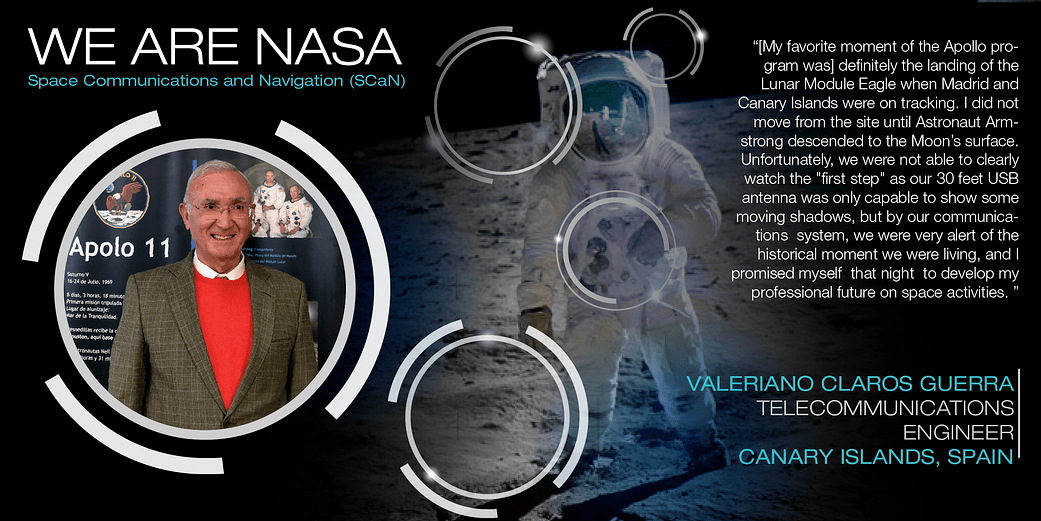Tell us more about your role during the Apollo mission.I joined as an Instituto Nacional de Técnica Aeroespacial (INTA) communications engineer at the Grand Canary (CYI) Apollo Station in February 1969. After attending the Apollo Indoctrination and several technical courses in NT&TF, I became assistant to the Bendix communications supervisor and later Assistant to the Bendix maintenance and operations manager. I was part of team responsible for the astronauts’ voice communications through the very high frequency (VHF) links antennas, and I was the interface with the Spanish Telefónica with the aim to improve the CYI communications back to Madrid, NASA’s Goddard Space Flight Center and Houston. This was accomplished when the first INTELSAT satellite communications ground station was established in Maspalomas, Grand Canary Island. I was on shifts in the control console during the Apollo flights and [also during tracking of] the Apollo Lunar Surface Experiments Package (ALSEP) when it left the Moon.
In October 1970, NASA and INTA nominated me for delegate of the Spanish INTA director with the following new duties: monitoring the government-to-government agreement with regard to information on the activities, conducting visits of Spanish authorities, developing proposals for scientific activities, administrative support with Spanish station personnel including new hires, and other matter with INTA station operations.
I remained in this position until CYI was closed on August 31, 1975 and the site infrastructure transferred to INTA, which reopened it in 1979.
What was your favorite moment from the Apollo program?[My favorite moment was] definitively the landing of the Lunar Module (LM) “Eagle”, when MAD and CYI were on tracking. I did not move from the site until Astronaut Armstrong descended to the Moon’s surface. Unfortunately, we were not able to clearly watch the “first step” as our 30 feet USB antenna was only capable to show some moving shadows, but, by our communications system, we were very aware of the historical moment we were living, and I did promise myself that night to develop my professional future in the space [field]. How did your work with NASA impact your career?The recommendation letter given to me by the NASA Site Director opened a wide door to my career: INTA rehired me as infrastructure engineer for Fresnedillas in 1975, and in 1976, I was moved to the the Villafranca Satellite Tracking Station (VILSPA) in Villanueva de la Cañada as maintenance and operations manager until 1988. In January 1989, I was selected for an European Space Agency (ESA) international vacancy announcement as director of VILSPA and a diplomatic representative in Spain. From 1999 to 2003, I was also the representative of ESA in Australia coordinating and supervising the establishment of the first ESA deep space station in New Norcia. In 2002, ESA also appointed me to manage the refurbishing of Deep Space Station (DSS)-63 from NASA’s Jet Propulstion Laboratory, now in Cebreros (transferred to INTA in 1987), in order to become the second ESA deep space tracking station. I completed my secondment to ESA in December 2005 and returned to INTA where I participated in the definition of the tracking antennas for the Spanish Satellites Paz and Ingenio. I retired in 2007. I rejoined INTA as a consultant in 2009 to participate in the establishiment of the third ESA deep space station in Malargüe, which was inaugurated 2013. My interest in space activities still continue, similarly as when I was working for Apollo flights, but now only giving talks, making presentations, writing articles, educating children and my grandsons on space missions.
How did the Apollo program set the precedence for future human exploration?
…I have no doubts that Apollo did and will continue to contribute to what the space traveling dreamer, Konstantin Tsiolkovsky, said. “The Earth is the cradle of humanity, but one can not remain in the cradle forever.
Learn more about how we are going forward to the Moon and Mars with the Artemis program.



























